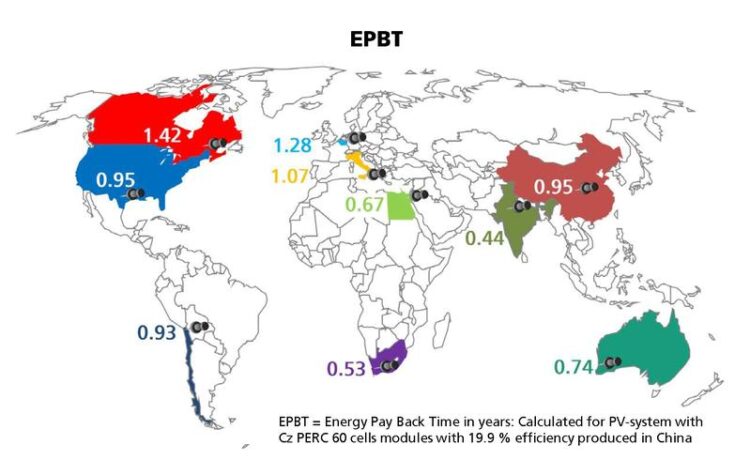Photovoltaics Report Delivers Facts about Solar Energy Worldwide

The energy payback time, or EPBT, for rooftop systems with silicon PV modules of 19.9 percent efficiency, manufactured in China, is one year and one to three months in Europe.
Data: Lorenz Friedrich, Fraunhofer ISE. Graph: PSE 2020. ©Fraunhofer ISE
The Fraunhofer Institute for Solar Energy Systems ISE, supported by PSE Projects GmbH, has been publishing the PV Report on a regular basis for the past decade. The report contains a compilation of the most important facts on photovoltaics (PV) in Germany, the European Union and worldwide, documenting, in particular, the development of the photovoltaic market, solar cell and module efficiency as well as the prices over the last decades. The latest edition is freely available on the Fraunhofer ISE website as of today.
The aim of the PV Report is to collect data from a wide variety of sources in one report, prepare it and make it easily accessible. Prof. Dr. Andreas Bett, director of Fraunhofer ISE, reflects: “Originally, we started this as a service for our scientists because we realized how time-consuming it is to obtain reliable facts on the photovoltaic market. As a solar research institute, we are happy to contribute an objective basis for discussion by making this data, which we have checked and prepared as comprehensibly as possible, available to everyone.”
The latest version of the PV Report contains updated figures on photovoltaic production, installation capacity and performance as well as other data, which has been compiled for the first time in this edition. For example, the energy payback time, or EPBT, is the period required by the PV system to produce the same amount of electricity (converted into equivalent primary energy) as produced by the grid for its manufacture. For the first time, the PV Report shows the historical development of the EPBT as well as comparable values for different geographical regions. For example, the EPBT of rooftop systems with silicon PV modules manufactured in China with an efficiency of 19.9 percent is between 1 and 1.3 years in Europe and between 0.44 (India) and 1.42 years (Canada) worldwide.
Also new is a map of Europe showing production capacities along the PV value chain for materials, solar cells and PV modules in the individual EU member states. From the map, one sees that production facilities are in operation in many European countries, particularly in the module sector with a total capacity of around 7 gigawatts (GW) per year. Likewise, production capacities for silicon material currently exist, which are equivalent to about 50 GW of solar power per year. Production facilities for solar cells are presently being expanded at a current rate of about 1 gigawatt per year.
Wissenschaftliche Ansprechpartner:
Dr. Simon Philipps: simon.philipps@ise.fraunhofer.de
Weitere Informationen:
https://www.ise.fraunhofer.de/en/publications/studies/photovoltaics-report.html Full Photovoltaics Report
https://www.ise.fraunhofer.de/en/publications/studies/recent-facts-about-pv-in-g… Current Facts on Photovoltaics in Germany
https://www.ise.fraunhofer.de/en/publications/studies.html Other studies and position papers of Fraunhofer ISE
Media Contact
All latest news from the category: Power and Electrical Engineering
This topic covers issues related to energy generation, conversion, transportation and consumption and how the industry is addressing the challenge of energy efficiency in general.
innovations-report provides in-depth and informative reports and articles on subjects ranging from wind energy, fuel cell technology, solar energy, geothermal energy, petroleum, gas, nuclear engineering, alternative energy and energy efficiency to fusion, hydrogen and superconductor technologies.
Newest articles

Silicon Carbide Innovation Alliance to drive industrial-scale semiconductor work
Known for its ability to withstand extreme environments and high voltages, silicon carbide (SiC) is a semiconducting material made up of silicon and carbon atoms arranged into crystals that is…

New SPECT/CT technique shows impressive biomarker identification
…offers increased access for prostate cancer patients. A novel SPECT/CT acquisition method can accurately detect radiopharmaceutical biodistribution in a convenient manner for prostate cancer patients, opening the door for more…

How 3D printers can give robots a soft touch
Soft skin coverings and touch sensors have emerged as a promising feature for robots that are both safer and more intuitive for human interaction, but they are expensive and difficult…





















